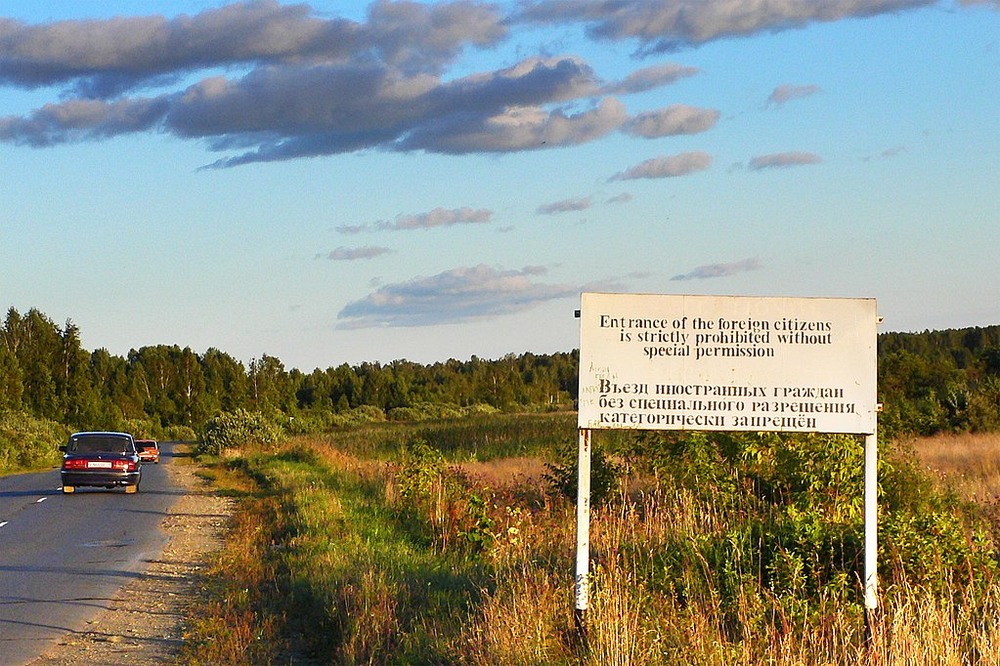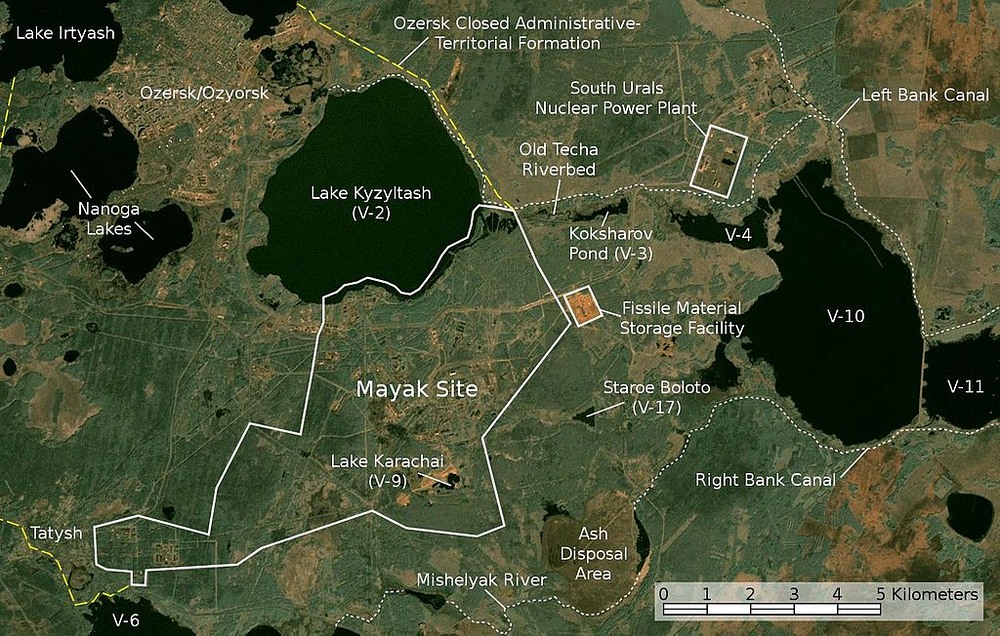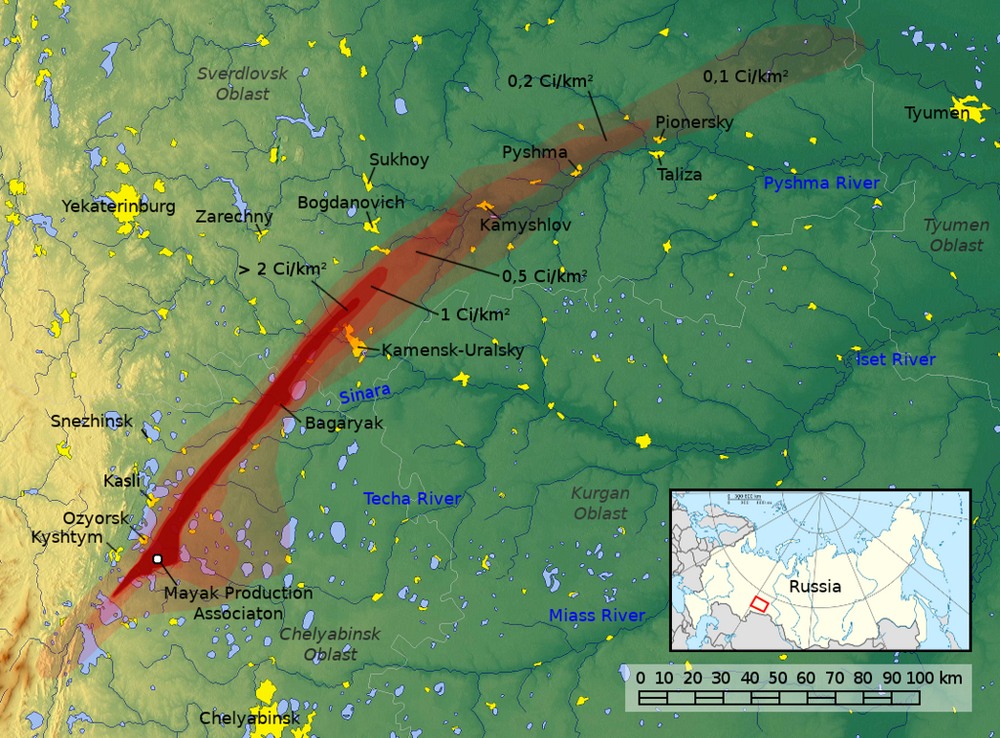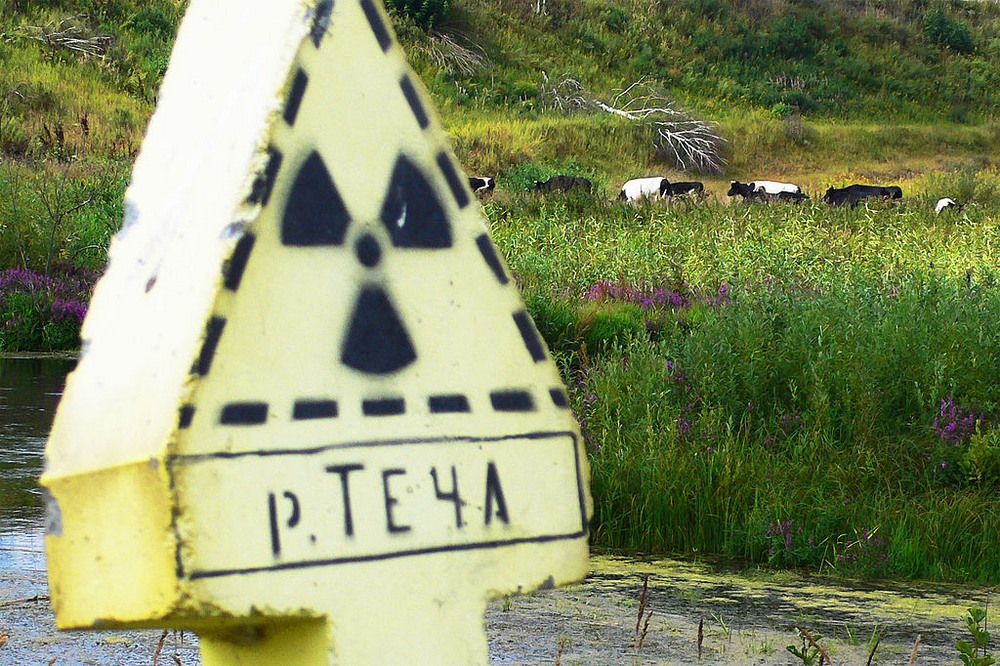Thirty years before the nuclear reactor at Chernobyl exploded, in what became one of the most devastating nuclear accidents in history, there was another major mishap at yet another Soviet nuclear power plant. It was hushed up by officials for more than three decades.
The accident took place at Mayak, one of Russia’s biggest nuclear facilities, located near the town of Kyshtym in the Chelyabinsk district in the Southern Ural mountains. The facility was built shortly after the end of the Second World War to serve as the location for the emerging Soviet nuclear program. Its primary purpose was to produce plutonium for the manufacture of nuclear weapons.

A forbidding sign near the closed city of Ozyorsk. Photo credit: Ecodefense/Wikimedia
The Soviet nuclear program started sluggishly. Soviet leaders did not have much faith in nuclear energy. Soviet scientists themselves thought that atomic weapons were unfeasible and aside from carrying academic merit, nuclear research had no practical applications. Consequently, most of the research done on the subject was unclassified and published under public domain in academic journals for anyone to read. Only Georgy Flyorov, a Russian physicist, noticed the complete lack of papers on nuclear science from German, British, and American scientists, and knew that something was up. Flyorov urged Stalin to restart the Soviet nuclear program. The great leader had shut it down and sent his scientists to work in the metallurgy and mining industry instead. It was only when the Soviet leaders saw the tremendous power of nuclear weapons demonstrated during the attack on Hiroshima and Nagasaki, did they realize how seriously behind were they in the nuclear arms race.
Mayak was built in 1948 in great haste. The Soviets had a lot of catching up to do. Lavrentiy Beria, a Marshal of the Soviet Union, the chief of secret police, and the head of the nuclear program, forced over 40,000 Gulag prisoners and POWs to build the plant and the closed city of Ozersk on the outskirts, where the staff and their families would live. Mayak was to be Russia’s largest nuclear reactor. The plant covers over 90 square kilometers, and is surrounded by an exclusion zone of 250 square kilometers. It was big enough to be a city, but Mayak and Ozersk was nowhere to be found on Soviet public maps. Its existence and location was kept a secret.
From the very beginning, Mayak was a dangerous facility. Little thought was given to worker’s safety or to the responsible disposal of waste materials. Radioactive waste produced from spent nuclear fuel was stored underground, but when the site ran out of space, instead of halting production until new underground facilities could be built, the highly radioactive material was dumped into the slow-moving Techa River, which was used by more than a hundred thousand people living in communities downriver. Furthermore, the reactors were cooled using water from Lake Kyzyltash in an open-cycle cooling system where the contaminated water was discharged directly back into the lake. Within a few years, the countryside and all water bodies around Mayak became heavily contaminated.

Satellite image of the Mayak nuclear facility.
Improper safety protocols resulted in several fatal accidents. One of the first recorded accident occurred in 1953, but went unnoticed until a worker developed severe radiation sickness requiring amputation of both legs. The most notable accident, the so-called “Kyshtym disaster” happened on 29 September 1957, when the cooling system of one of the waste storage tanks failed but went undetected until the tank exploded with a force equivalent to about 70 tons of TNT. While there was no immediate casualties from the explosion, the violence sent a plume of radioactive fallout soaring into the sky to an altitude of one kilometer.
That afternoon, residents of the Chelyabinsk district noticed unusual colors in the sky. The local press speculated about polar lights appearing exceptionally far south. Because of the secrecy surrounding Mayak, these villagers were not informed about the accident. Over the next few days, the radioactive cloud drifted northeast for hundreds of miles contaminating an area of roughly 15,000 to 20,000 square kilometers and putting at risk the lives of 270,000 people.
Evacuation of the nearest settlement began one week later. People were not told what happened, just asked to pack their bags and leave. Only about 10,000 people were evacuated, over a period of two years.

Map of the area contaminated by the Kyshtym disaster. Image credit: Goran tek-en/Wikimedia
Vague reports about a possible catastrophic accident began appearing in the Western press as early as 1958. A Copenhagen newspaper broke the story first which alleged it was a factor in the Soviet decision to suspend nuclear tests unilaterally in March of that year. One year later in 1959, another account appeared in an Austrian newspaper. These reports were systematically denied by Soviet Government officials. The picture became somewhat clear only in 1976, when Zhores Medvedev, an exiled Soviet biologist living in England published a series of articles about the disaster in New Scientist.
Medvedev's allegations were corroborated by an account by Lev Tumerman, a Soviet scientist who in 1960 traveled through the alleged contaminated area. Tumerman, who later emigrated to Israel, wrote letters to the Jerusalem Post, and to The London Times stating:
About 100 kilometres from Sverdlovsk, a highway sign warned drivers not to stop for the next 20 or 30 kilometres and to drive through at maximum speed. On both sides of the road, as far as one could see, the land was 'dead’: no villages, no towns, only the chimneys of destroyed houses, no cultivated fields or pastures, no herds, no people...nothing.
In personal correspondence with researchers of the Los Alamos National Laboratory, Tumerman further stated:
What I saw personally, was a large area in the vicinity of Sverdlovsk (no less than 100 to 150 sq. km and probably much more), in which any normal human activity was forbidden, people were evacuated and villages razed, evidently to prevent inhabitants from returning, there was no agriculture or live-stock raising, fishing and hunting were forbidden.

Photo credit: Ecodefense/Wikimedia
These reports were, however, in the eyes of the scientific community nothing more than hearsay. In the absence of verifiable information, many doubted Medvedev’s account. Although the existence of a vast contaminated area was confirmed by a report prepared by researchers at Oak Ridge National Laboratory in Tennessee, no concrete evidence was found that the contamination was caused by a nuclear accident. It wasn’t until the breakup of the Soviet Union, that the true scale of the accident emerged.
The true number of fatalities of the Kyshtym disaster is difficult to assess, partly because of the secrecy and partly because the Mayak facility had already contaminated the area by routinely releasing dangerous quantities of radioactive waste into the environment for many years. According to Zhores Medvedev, the Kyshtym disaster was worse than Chernobyl because of the release of a larger quantity of the long-term radioactive substance Strontium-90 than Chernobyl. Instances of cancer, birth defects and other major health problems remain high among inhabitants of the region to this day.

Cows and a radiation danger warning sign at the river Techa. Photo credit: Ecodefense/Wikimedia


